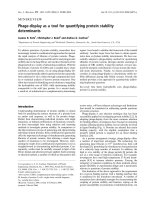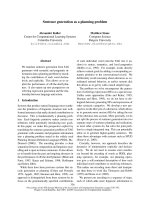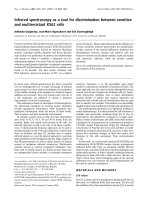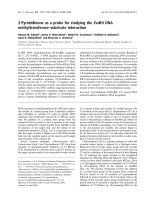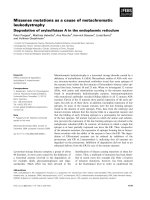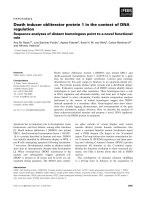báo cáo khoa học: "Dermatofibrosarcoma presenting as a nodule in the breast of a 75-year-old woman: a case report" pps
Bạn đang xem bản rút gọn của tài liệu. Xem và tải ngay bản đầy đủ của tài liệu tại đây (3.49 MB, 8 trang )
JOURNAL OF MEDICAL
CASE REPORTS
Dermatofibrosarcoma presenting as a nodule in
the breast of a 75-year-old woman: a case report
Cottier et al.
Cottier et al. Journal of Medical Case Reports 2011, 5:503
(5 October 2011)
CAS E REP O R T Open Access
Dermatofibrosarcoma presenting as a nodule in
the breast of a 75-year-old woman: a case report
Olivier Cottier
1*
, Maryse Fiche
2
, Jean-Yves Meuwly
3
and Jean-François Delaloye¹
1
Abstract
Introduction: Dermatofibrosarcoma protuberans is a rare neoplasm of soft tissues and its location in the breast is
extremely uncommon. Confusion is possible with other primary breast lesions.
Case presentation: A 75-year-old Caucasian woman presented with a mass in her left breast 21 years after being
diagnosed with invasive ductal carcinoma of the right breast, treated by a right mastectomy and axillary dissection
followed by radiotherapy and breast reconstruction. Mammography revealed a dish-shaped skin nodule formation
in the upper outer quadrant of her left breast. Echography confirmed the presence of a lesion measuring 1.4 × 0.8
cm. Based on imaging, the diagnosis was a probable angiosarcoma. Due to the presence of a pacemaker for
cardiac arrhythmia and full anticoagulation therapy for a pulmonary embolism, magnetic resonance imaging and a
biopsy were not done. We proceeded directly to a quadrantectomy and the fin al diagnosis revealed a
dermatofibrosarcoma protuberans, 1. 8 cm in its greatest microscopic dimension, located 0.1 cm from the upper
surgical margin. To ensure the wide resection margins required for this type of neoplasm, a re-excision was
performed.
Conclusion: A dermatofibrosarcoma protuberans of the breast is an uncommon discovery. The aim of this case
report is to highlight the importance of the surgical procedure in cases of the discovery of dermatofibrosarcoma
protuberans. Re-excision may be necessary to ensure adequate resection margins.
Introduction
Dermatofibrosarcoma protuberans (DFSP) is a rare neo-
plasm of soft tissues described in 1924 by D arier and
Ferrand as “progressive recurrent dermatofibroma” and
by Hoffmann in 1925 as ‘dermatofibrosarcoma protuber-
ans’. This tumor is a dermal spindle cell tumor of inter-
mediate malignancy characterized by a slow evolution, a
significant risk of local recurrence and a low rate of
metastasization [1]. DFSP typically presents during early
or middle adult life in all parts of the body, although
more frequently on the trunk, ex tremities, and head and
neck [1]. Its location in the breast is extremely rare and
very few cases have been reported in the literature. Con-
fusion is possible with other primary breast lesions [2,3].
Case presentation
We present here the case of a 75-year-old Caucasian
woman, who 21 years ago und erwent a right mastect-
omy and axillary dissection followed by radiotherapy
and breast reconstruction with a prosthesis for invasive
ductal carcinoma of her right breast, and now presented
with a mass in her left breast. Mammography showed a
dish-shaped skin nodule in the upper outer quadrant of
her left breast (Figures 1 and 2). Echography confirmed
the presence of a lesion measuring 14 × 8 mm. Based
on imaging, the diagnosis was a probable angiosarcoma
(Figures 3 and 4). She has a history of hypertension, a
pacemaker for cardiac arrhythmia and was also treated
with acenocoumarol for a pulmonary embolism two
years ago. Magnetic resonance imaging (MRI) was not
feasible due to the pacemaker. We proceeded to a quad-
rantect omy after modifying ant icoagulation therapy. Her
postoperative recovery was uneventful.
At gross examination, the specimen me asured 11 × 11
× 4 cm and harbored a 1 × 1 cm well delineated dermal
nodule close to the upper surgical margin. The cut
* Correspondence:
1
Département de Gynécologie-Obstétrique et Génétique, Centre Hospitalier
Universitaire Vaudois, Lausanne, Suisse
Full list of author information is available at the end of the article
Cottier et al. Journal of Medical Case Reports 2011, 5:503
/>JOURNAL OF MEDICAL
CASE REPORTS
© 2011 Cottier et al; lice nsee BioMed Central Lt d. This is an Open Access article distributed under the terms of the Creative Co mmons
Attribution License (http://creativec ommons.org/licenses/by/2.0), which permits unrestricted use, distribution, and reproduction in
any medium, provided the original work is properly cited.
section showed a solid whitish tumor with foci of
hemorrhage (Figures 5 and 6). Mi croscopic examination
revealed a proliferation of bland spindle cells arranged
in a storiform pattern extending into hypodermal fat
(Figures 7 and 8). These cells diffusely and strongly
expressed the CD34 antigen, and were negative for
CD31 and S-100 protein (Figure 9). The diagnosis was
DFSP; 1.8 cm in its greatest microscopic dimension
located 0.1 cm from the upper sur gical margin. To
ensure the wide resection margins required for this type
of neoplasm, a re-excision was performed, up to the
pectoral muscle fascia and including some muscle fibers.
Pathology examination showed no residual tumor. This
re-excision allowed for additional safety margins of at
least 5 cm. No additional treatment was done. Our
patient is well with no e vidence of recurrence one year
after surgery.
Discussion
DFSP represents about 1% of soft tissue sarcomas with
an estimated incidence of 0.8 to 5.0 cases per million
per year [2,4] . Forty-seven percent of DFSP cases occur
on the trunk [1]. Breast localization of DFSP is rare
[3,5]. In most cases, mammography reveals a dense
lesion without fat or calcification. Ult rasound
expl orat ion identifies the l esio n in the dermis or sub cu-
taneous tissue and the use of Doppler shows hypervas-
cularization of the area [3]. Even in a patient receiving
anticoagulation therapy, core biopsy is an option: this
biopsy is essential to obtain a diagnosis in order to plan
a one-time wide excision. MRI may be helpful to def ine
the depth of infiltration of the tumor [5].
Pathologic examination reveals monotonous spindle
cells arranged in a storiform pattern, extending to the
hypodermal fat in a typical honeycomb pattern [6]. The
differential diagnosis includes mainly benign fibrous his-
tiocytoma, and also neurofibroma and myxoid liposarcoma
[1]. DFSP cells are typically diffusely positive for CD34,
which indicates a close link between this neoplasm and
normal CD34 positive dermic dendritic cells [1]. Genetic
abnormalities associated withDFSPincludeasupernu-
merary ring chromosome, cor responding t o the low
amplification of sequences of chromosomes 17 and 22,
and/or the presence of t(17;22), a balanced reciprocal
translocation. This translocation fuses the platelet-derived
growth factor beta-chain (PDGF-beta) gene to the collagen
type 1, alpha 1 gene [6]. The fusion prot ein, which has a
PDFG-beta-type effect, participates in cell proliferation
and can be blocked by tyrosine kinase inhibitors[7].
Figure 1 Mammography. Mediolateral oblique view; appearance
of a nodular formation of her left breast.
Figure 2 Mammography. Craniocaudal view.
Cottier et al. Journal of Medical Case Reports 2011, 5:503
/>Page 2 of 7
Figure 3 Ultrasonography. Nodular lesion in her left breast measuring 1.4 × 0.8 cm.
Figure 4 Ultrasonography. Highly vascular lesion in the Doppler mode.
Cottier et al. Journal of Medical Case Reports 2011, 5:503
/>Page 3 of 7
Figure 5 Pathology (gross). The quadrantectomy specimen (11 × 11 × 4 cm).
Figure 6 Pathology (gross). Well-defined bluish nodule of 1 × 1 cm, with areas of hemorrhage (arrow).
Cottier et al. Journal of Medical Case Reports 2011, 5:503
/>Page 4 of 7
Epidermis
Adipose
tissue
Tumor
Figure 7 Pathology (microscopy). The tumor infiltrates the hypodermal adipose tissue.
Figure 8 Pathology (microscopy). Proliferation of spindle cells with elongated nuclei and moderate nuclea r pleomorphism; fewer than four
mitoses per 10 high power fields have been counted.
Cottier et al. Journal of Medical Case Reports 2011, 5:503
/>Page 5 of 7
Safety margins should be of several centimeters of
healthy tissue and should have an anatomical border not
invaded at depth. The appropriate distance between fr ee
surgical margins and the tumor, however, is not estab-
lished. Some authors recommend Mohs surgery; micro-
graphic surgery using the microscope to trace out the
ramifications as describe by Mohs in 1978. This offers a
complete evaluatio n of the peripheral and d eep margins
using frozen section or accelerated standard histology
[8,9]. Wide first intention local excision may be prefe r-
able in the parts of the body where it is easy (like trunk
and limb), resulting in an overall shorter procedure [9].
A plastic surgeon s hould be present if wound closure
difficulties are anticipated.
Local recurrence rate varies between 1.6% and 50%
depending on the type of surgery used [6,10,11]. Mohs
surgery results in extremely low local recurrence rates
and, accordin gly, a cure rate of up to 98 .5% [12]. Regio-
nal and distant recurr ences are infrequent (regional
lymph node metastases and distant metastases, princi-
pally in the lung), estimated at less than 5% of cases
[11]. Complementary radiation therapy or chemotherapy
seem not to bring any benefit [13]. However, specific
tyrosine kinase inhibitors (for example imatinib, which
inhibits the PDGF-beta rece ptor) appear promising [7].
Long-term follow-up requires strict monitoring every six
to twelve months with ultrasound and biopsy in cases of
suspected recurrence. The five-year survival ra te of
patients with DFSP is over 99% [14,15].
Conclusion
Breast localization of DFSP is extremely uncommon and
can mimic a primary breast tumor. As in other locations
of DFSP, surgical excision with adequate resection mar-
gins is recommended to ensure local control of the dis-
ease. A plastic surgeon should be present if difficulty
withthewoundclosurebyfirstintentionistobe
expected.
Consent
Written informed consent was obtained from the patient
for publicatio n of this case report and any accompany-
ing images. A copy of the written consent is available
for review by the Editor-in-Chief of this journal.
Author details
1
Département de Gynécologie-Obstétrique et Génétique, Centre Hospitalier
Universitaire Vaudois, Lausanne, Suisse.
2
Institut Universitaire de Pathologie,
Centre Hospitalier Universitaire Vaudois, Lausanne, Suisse.
3
Service de
Radiodiagnostic et de Radiologie Interventionnelle, Centre Hospitalier
Universitaire Vaudois, Lausanne, Suisse.
Authors’ contributions
OC and JFD analyzed and interpreted the patient data. MF performed the
histological examination. JYM performed the imaging and ultrasonography.
OC was a major contributor in writing the manuscript. MF wrote the
pathology section. All authors read and approved the final manuscript.
Competing interests
The authors declare that they have no competing interests.
Received: 9 April 2011 Accepted: 5 October 2011
Published: 5 October 2011
Figure 9 Pathology (immunohistochemistry). Tumor cells diffusely and strongly expressed the CD34 antigen.
Cottier et al. Journal of Medical Case Reports 2011, 5:503
/>Page 6 of 7
References
1. In Enzinger and Weiss’s Soft Tissue Tumors 5 edition. Edited by: Weiss SC,
Goldblum JR. Mosby; Elsevier; Philadelphia; 2008:371-382.
2. Lin JY, Sheen-Chen SM, Hsu W, Huang CC, Ko SF, Eng HL:
Dermatofibrosarcoma protuberans of the breast. Tumori 2008,
94(6):861-863.
3. Liu SZ, Ho TL, Hsu SM, Zhan HL, Chou CP: Imaging of
dermatofibrosarcoma protuberans of breast. Breast J 2010, 16(5):541-543.
4. Ruiz-Tovar J, Fernandez GM, Reguero Callejas ME, Aguilera VA, Arano BJ,
Cabanas NL: Dermatofibrosarcoma protuberans: review of 20-years
experience. Clin Transl Oncol 2006, 8(8):606-610.
5. Lee SJ, Mahoney MC, Shaughnessy E: Dermatofibrosarcoma protuberans
of the breast: imaging features and review of the literature. AJR Am J
Roentgenol 2009, 193(1):W64-W69.
6. Guillou L: Fibroblastic and fibrohistiocytic tumors. In Bone and Soft Tissue
Pathology, Foundations in Diagnostic Pathology series. Edited by: Folpe AL,
Inwards C. Saunders; Elsevier; Philadelphia; 2010:79-83.
7. Lemm D, Mugge LO, Mentzel T, Hoffken K: Current treatment options in
dermatofibrosarcoma protuberans. J Cancer Res Clin Oncol 2009,
135(5):653-665.
8. Mohs FE: Chemosurgery for the microscopically controlled excision of
cutaneous cancer. Head Neck Surg 1978, 1(2):150-166.
9. Paradisi A, Abeni D, Rusciani A, Cigna E, Wolter M, Scuderi N, Rusciani L,
Kaufmann R, Podda M: Dermatofibrosarcoma protuberans: wide local
excision vs. Mohs micrographic surgery. Cancer Treat Rev 2008,
34(8):728-736.
10. Gloster HM Jr, Harris KR, Roenigk RK: A comparison between Mohs
micrographic surgery and wide surgical excision for the treatment of
dermatofibrosarcoma protuberans. J Am Acad Dermatol 1996, 35(1):82-87.
11. Rutgers EJ, Kroon BB, Albus-Lutter CE, Gortzak E: Dermatofibrosarcoma
protuberans: treatment and prognosis. Eur J Surg Oncol 1992,
18(3):241-248.
12. Snow SN, Gordon EM, Larson PO, Bagheri MM, Bentz ML, Sable DB:
Dermatofibrosarcoma protuberans: a report on 29 patients treated by
Mohs micrographic surgery with long-term follow-up and review of the
literature. Cancer 2004, 101(1):28-38.
13. Grimer R, Judson I, Peake D, Seddon B: Guidelines for the management of
soft tissue sarcomas. Sarcoma 2010, 2010:506182.
14. National Comprehensive Cancer Network Dermatofibrosarcoma Protuberans
and Merkel Cell Carcinoma: Dermatofibrosarcoma protuberans. Clinical
practice guidelines in oncology. J Natl Compr Canc Netw 2004, 2(1):74-78.
15. Dragoumis DM, Katsohi LA, Amplianitis IK, Tsiftsoglou AP: Late local
recurrence of dermatofibrosarcoma protuberans in the skin of female
breast. World J Surg Oncol 2010, 8:48.
doi:10.1186/1752-1947-5-503
Cite this article as: Cottier et al.: Dermatofibrosarcoma presenting as a
nodule in the breast of a 75-year-old woman: a case report. Journal of
Medical Case Reports 2011 5:503.
Submit your next manuscript to BioMed Central
and take full advantage of:
• Convenient online submission
• Thorough peer review
• No space constraints or color figure charges
• Immediate publication on acceptance
• Inclusion in PubMed, CAS, Scopus and Google Scholar
• Research which is freely available for redistribution
Submit your manuscript at
www.biomedcentral.com/submit
Cottier et al. Journal of Medical Case Reports 2011, 5:503
/>Page 7 of 7


